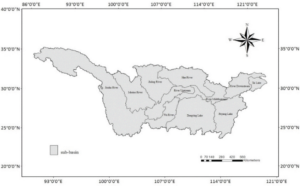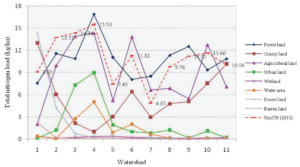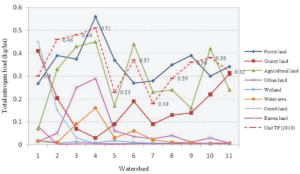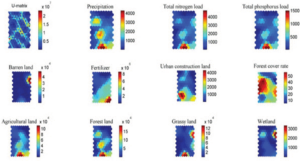Correlation between Different Factors of Non-point Source Pollution in Yangtze River Basin
Introduction
Understanding the impact of Water Quality, Soil Science, and Earth Science is essential to managing environmental pollution effectively. The study titled “Correlation between Different Factors of Non-Point Source Pollution in the Yangtze River Basin”, published in IgMin Research, offers valuable insights into how various factors influence non-point source (NPS) pollution in one of the most significant river basins in the world.
This blog post explores the key findings of the study, focusing on the intersection of Water Quality, Soil Science, and Earth Science, and highlights the importance of managing NPS pollution for sustainable environmental practices.
For more details, read the full study: Full Text | PDF
Understanding Non-Point Source Pollution
Non-Point Source (NPS) Pollution refers to diffuse contamination that does not originate from a single, identifiable source. Unlike point source pollution, which comes from specific locations like factories or sewage treatment plants, NPS pollution results from runoff that picks up pollutants from various sources and deposits them into water bodies.
The study identifies key contributors to NPS pollution, particularly from agricultural activities, which introduce significant amounts of nitrogen (N) and phosphorus (P) into the environment. These nutrients can harm Water Quality and lead to issues like algal blooms, which reduce oxygen levels and affect aquatic ecosystems.
The Yangtze River Basin: A Case Study in NPS Pollution
The Yangtze River Basin in southern China covers an area of about 1.8 million square kilometers. It has a subtropical monsoon climate with an average annual temperature between 15°C and 19°C and annual precipitation of 1,067 mm.
The study divides the basin into 11 sub-basins:
- Jinsha River Sub-Basin
- Han River Sub-Basin
- River Downstream Sub-Basin
- Tai Lake Sub-Basin
- Poyang Lake Sub-Basin
- River Middle Stream Sub-Basin
- Dong Ting Lake Sub-Basin
- Wu River Sub-Basin
- River Upstream Sub-Basin
- Jialing River Sub-Basin
- Min Tuo River Sub-Basin
Each sub-basin has unique characteristics that influence the levels of nitrogen and phosphorus in the water.
 Figure 1: Distribution of sub-basins in the Yangtze River Basin. (Source: http://www.geodata.cn/)
Figure 1: Distribution of sub-basins in the Yangtze River Basin. (Source: http://www.geodata.cn/)
Key Findings on Water Quality and Soil Science
The study used the Improved Export Coefficient Model (IECM) to estimate nutrient pollutant loads in the Yangtze River Basin. Here are some of the key findings:
- Total Nitrogen Load: Ranges from 4.87 to 15.53 kg/ha across sub-basins.
- Total Phosphorus Load: Ranges from 0.18 to 0.51 kg/ha across sub-basins.
- Dong Ting Lake Sub-Basin: Has the lowest contribution of nitrogen and phosphorus.
- Tai Lake Sub-Basin: Shows the highest nitrogen and phosphorus loads, particularly from forest, agricultural, and urban construction lands.
These findings highlight the critical role of Soil Science in understanding how different land uses affect nutrient pollution levels.
 Figure 2: Contribution of total nitrogen load.
Figure 2: Contribution of total nitrogen load.
 Figure 3: Contribution of total phosphorus load.
Figure 3: Contribution of total phosphorus load.
The Role of Earth Science in NPS Pollution Management
Earth Science plays a crucial role in managing NPS pollution by providing insights into the geographical and climatic factors that influence pollutant distribution. The study used digital elevation models (DEM) and satellite imagery to analyze land use patterns and topography in the Yangtze River Basin.
Land Use Categories Analyzed:
- Forest Land
- Grassy Land
- Agricultural Land
- Built-Up Land
- Water Bodies
- Wetlands
- Desert Land
- Barren Land
These categories help environmental managers understand how different types of land use contribute to NPS pollution and develop targeted strategies to reduce pollutant loads.
Correlation of Factors Influencing NPS Pollution
The study applied a Self-Organizing Map (SOM) model to identify the correlation between various factors affecting NPS pollution. Key correlations include:
- Precipitation and Nutrient Load: Higher precipitation levels correlate with increased nitrogen and phosphorus runoff.
- Land Use Patterns: Agricultural, forest, and grassy lands show significant correlations with nitrogen and phosphorus levels.
- Wetland and Barren Land: These areas show the lowest correlations with nutrient pollution.
Understanding these correlations is essential for developing effective pollution management strategies.
 Figure 4: Factor correlation in the Yangtze River Basin.
Figure 4: Factor correlation in the Yangtze River Basin.
The Importance of Managing Water Quality
Managing Water Quality is crucial for maintaining healthy ecosystems and ensuring sustainable water resources. The study highlights the following strategies for managing NPS pollution:
- Implementing Buffer Zones: Planting vegetation along waterways to reduce runoff.
- Improving Agricultural Practices: Using precision agriculture to minimize fertilizer use.
- Restoring Wetlands: Wetlands act as natural filters, reducing nutrient loads in water bodies.
These strategies can help reduce the impact of NPS pollution and improve Water Quality in the Yangtze River Basin and beyond.
Conclusion
The study of Water Quality, Soil Science, and Earth Science in the Yangtze River Basin provides valuable insights into managing non-point source pollution. By understanding the correlation between various factors, environmental managers can develop targeted strategies to reduce nutrient loads and improve the health of water bodies.
